2007 Hyundai Santa Fe rear seats
[x] Cancel search: rear seatsPage 45 of 355
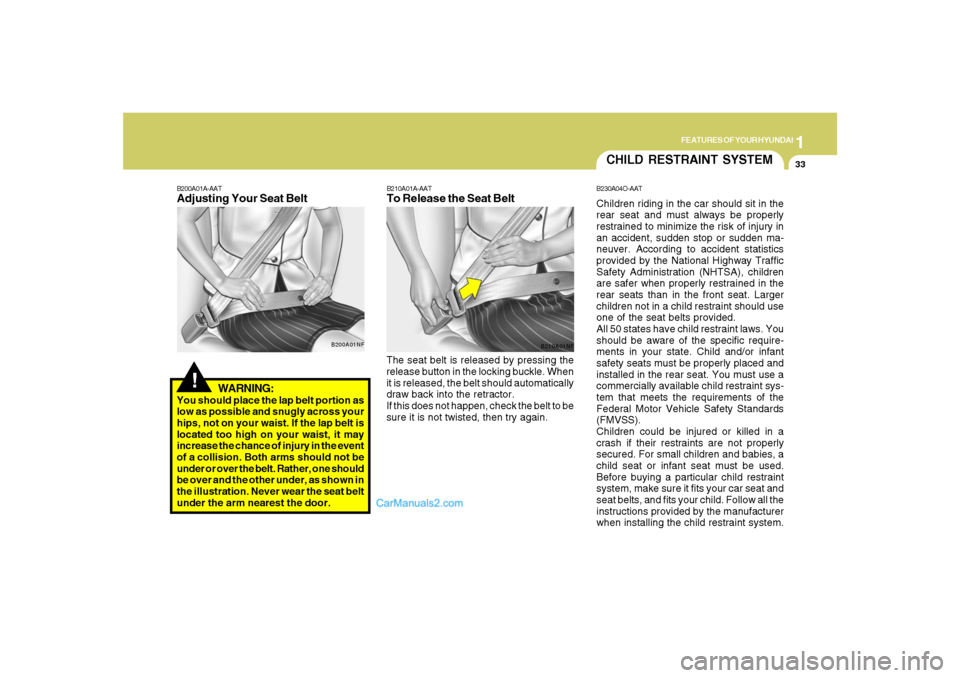
1
FEATURES OF YOUR HYUNDAI
33
WARNING:
You should place the lap belt portion as
low as possible and snugly across your
hips, not on your waist. If the lap belt is
located too high on your waist, it may
increase the chance of injury in the event
of a collision. Both arms should not be
under or over the belt. Rather, one should
be over and the other under, as shown in
the illustration. Never wear the seat belt
under the arm nearest the door.
!
B200A01A-AATAdjusting Your Seat Belt
B200A01NF
The seat belt is released by pressing the
release button in the locking buckle. When
it is released, the belt should automatically
draw back into the retractor.
If this does not happen, check the belt to be
sure it is not twisted, then try again.B210A01A-AATTo Release the Seat Belt
B210A01NF
CHILD RESTRAINT SYSTEMB230A04O-AATChildren riding in the car should sit in the
rear seat and must always be properly
restrained to minimize the risk of injury in
an accident, sudden stop or sudden ma-
neuver. According to accident statistics
provided by the National Highway Traffic
Safety Administration (NHTSA), children
are safer when properly restrained in the
rear seats than in the front seat. Larger
children not in a child restraint should use
one of the seat belts provided.
All 50 states have child restraint laws. You
should be aware of the specific require-
ments in your state. Child and/or infant
safety seats must be properly placed and
installed in the rear seat. You must use a
commercially available child restraint sys-
tem that meets the requirements of the
Federal Motor Vehicle Safety Standards
(FMVSS).
Children could be injured or killed in a
crash if their restraints are not properly
secured. For small children and babies, a
child seat or infant seat must be used.
Before buying a particular child restraint
system, make sure it fits your car seat and
seat belts, and fits your child. Follow all the
instructions provided by the manufacturer
when installing the child restraint system.
Page 49 of 355
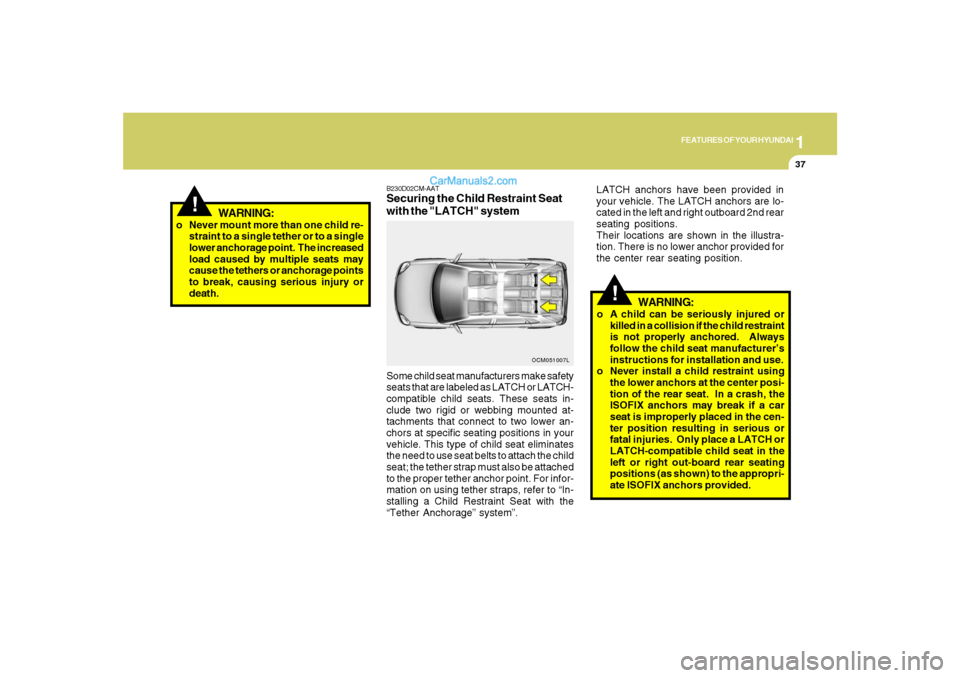
1
FEATURES OF YOUR HYUNDAI
37
!
WARNING:
o Never mount more than one child re-
straint to a single tether or to a single
lower anchorage point. The increased
load caused by multiple seats may
cause the tethers or anchorage points
to break, causing serious injury or
death.
!
WARNING:
o A child can be seriously injured or
killed in a collision if the child restraint
is not properly anchored. Always
follow the child seat manufacturer’s
instructions for installation and use.
o Never install a child restraint using
the lower anchors at the center posi-
tion of the rear seat. In a crash, the
ISOFIX anchors may break if a car
seat is improperly placed in the cen-
ter position resulting in serious or
fatal injuries. Only place a LATCH or
LATCH-compatible child seat in the
left or right out-board rear seating
positions (as shown) to the appropri-
ate ISOFIX anchors provided.
B230D02CM-AATSecuring the Child Restraint Seat
with the "LATCH" systemSome child seat manufacturers make safety
seats that are labeled as LATCH or LATCH-
compatible child seats. These seats in-
clude two rigid or webbing mounted at-
tachments that connect to two lower an-
chors at specific seating positions in your
vehicle. This type of child seat eliminates
the need to use seat belts to attach the child
seat; the tether strap must also be attached
to the proper tether anchor point. For infor-
mation on using tether straps, refer to “In-
stalling a Child Restraint Seat with the
“Tether Anchorage” system”.
OCM051007L
LATCH anchors have been provided in
your vehicle. The LATCH anchors are lo-
cated in the left and right outboard 2nd rear
seating positions.
Their locations are shown in the illustra-
tion. There is no lower anchor provided for
the center rear seating position.
Page 50 of 355
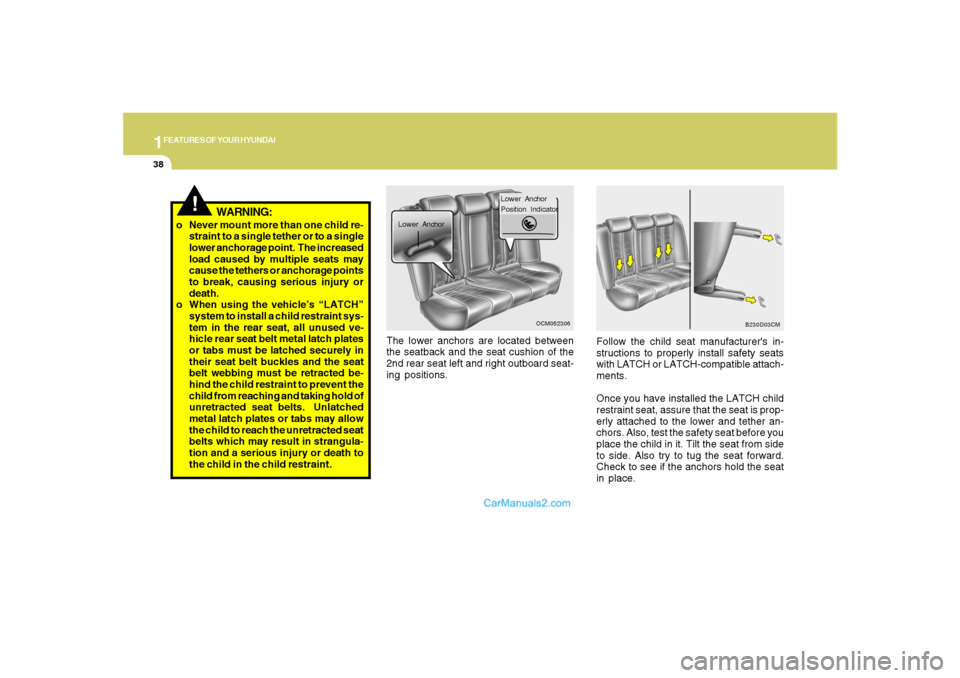
1FEATURES OF YOUR HYUNDAI38
The lower anchors are located between
the seatback and the seat cushion of the
2nd rear seat left and right outboard seat-
ing positions.Follow the child seat manufacturer's in-
structions to properly install safety seats
with LATCH or LATCH-compatible attach-
ments.
Once you have installed the LATCH child
restraint seat, assure that the seat is prop-
erly attached to the lower and tether an-
chors. Also, test the safety seat before you
place the child in it. Tilt the seat from side
to side. Also try to tug the seat forward.
Check to see if the anchors hold the seat
in place.
Lower Anchor
Position Indicator
Lower Anchor
OCM052306
B230D03CM
!
o Never mount more than one child re-
straint to a single tether or to a single
lower anchorage point. The increased
load caused by multiple seats may
cause the tethers or anchorage points
to break, causing serious injury or
death.
o When using the vehicle’s “LATCH”
system to install a child restraint sys-
tem in the rear seat, all unused ve-
hicle rear seat belt metal latch plates
or tabs must be latched securely in
their seat belt buckles and the seat
belt webbing must be retracted be-
hind the child restraint to prevent the
child from reaching and taking hold of
unretracted seat belts. Unlatched
metal latch plates or tabs may allow
the child to reach the unretracted seat
belts which may result in strangula-
tion and a serious injury or death to
the child in the child restraint.
WARNING:
Page 52 of 355

1FEATURES OF YOUR HYUNDAI40
!
WARNING:
o If the retractor is not in the Automatic
Locking mode, the child restraint can
move when your vehicle turns or stops
suddenly. A child can be seriously
injured or killed if the child restraint is
not properly anchored to the car, in-
cluding setting the retractor to the
Automatic Locking mode.
o Do not install any child restraint sys-
tem in the front passenger seat.
Should an accident occur and cause
the passenger side air bag to deploy,
it could severely injure or kill an infant
or child seated in an infant or child
seat. Therefore, only use a child re-
straint system in the rear seat of your
vehicle.
o Before installing Child Restraint Sys-
tems, refer to safety notices for Cur-
tain Air Bag systems beginning on
page 1-58 this manual. Whenever in-
stalling child restraints, use only ap-
proved devices and refer to the "Child
Restraint System" section to ensure
correct installation and occupant pro-
tection is maximized. Also, double check to be sure that the
retractor has engaged the Automatic Lock-
ing feature by trying to extend webbing out
of the retractor. If the retractor is in the
Automatic Locking mode, the belt will be
locked. After installation of the child re-
straint system, try to move it in all directions
to be sure the child restraint system is se-
curely installed. If you need to tighten the
belt, pull more webbing toward the retrac-
tor. When you unbuckle the seat belt and
allow it to retract, the retractor will automati-
cally revert back to its normal seated pas-
senger Emergency Locking usage condi-
tion.
NOTE:o Before installing the child restraint
system in any seating position, read
the instructions supplied by the child
restraint system manufacturer.
o If the seat belt does not operate as
described, have the system checked
immediately by your authorized
Hyundai dealer.
B230G01CM-AATChild Restraint System Installation
on Outboard Rear SeatsTo install a child restraint system in the
outboard rear seats, extend the shoulder/
lap belt entirely from its retractor until a
"click" is felt. This will engage the seat belt
retractor automatic locking feature, which
allows the seat belt to retract but not ex-
tend. Install the child restraint system,
buckle the seat belt and allow the seat belt
to take up any slack. Make sure that the lap
portion of the belt is tight around the child
restraint system and the shoulder portion
of the belt is positioned so that it can not
interfere with the child's head or neck.
B230G01NF-B
Page 59 of 355
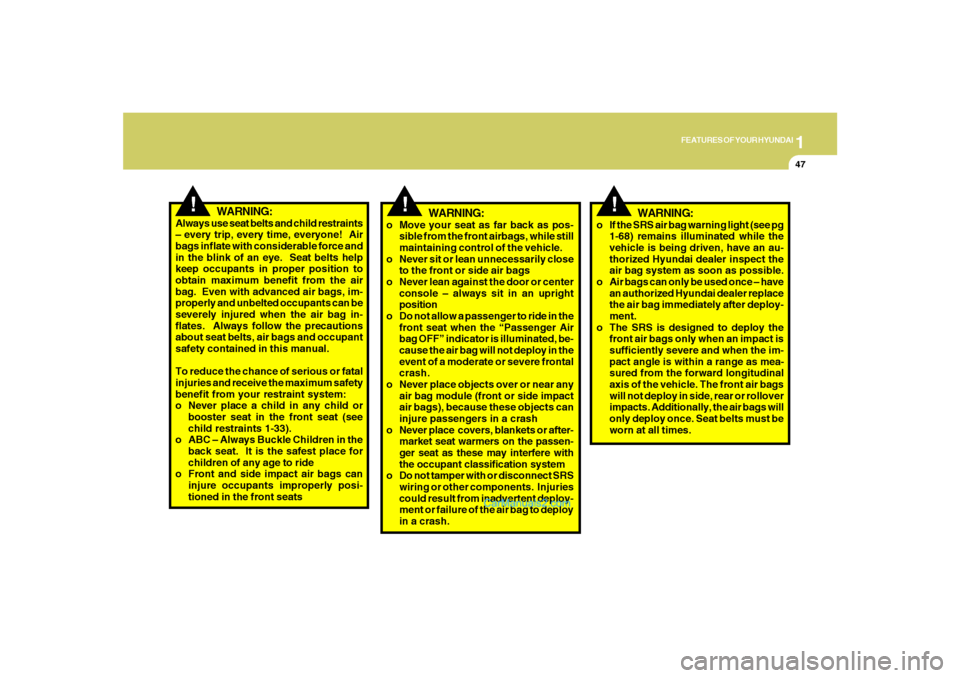
1
FEATURES OF YOUR HYUNDAI
47
!
!
WARNING:
!
WARNING:
Always use seat belts and child restraints
– every trip, every time, everyone! Air
bags inflate with considerable force and
in the blink of an eye. Seat belts help
keep occupants in proper position to
obtain maximum benefit from the air
bag. Even with advanced air bags, im-
properly and unbelted occupants can be
severely injured when the air bag in-
flates. Always follow the precautions
about seat belts, air bags and occupant
safety contained in this manual.
To reduce the chance of serious or fatal
injuries and receive the maximum safety
benefit from your restraint system:
o Never place a child in any child or
booster seat in the front seat (see
child restraints 1-33).
o ABC – Always Buckle Children in the
back seat. It is the safest place for
children of any age to ride
o Front and side impact air bags can
injure occupants improperly posi-
tioned in the front seatso Move your seat as far back as pos-
sible from the front airbags, while still
maintaining control of the vehicle.
o Never sit or lean unnecessarily close
to the front or side air bags
o Never lean against the door or center
console – always sit in an upright
position
o Do not allow a passenger to ride in the
front seat when the “Passenger Air
bag OFF” indicator is illuminated, be-
cause the air bag will not deploy in the
event of a moderate or severe frontal
crash.
o Never place objects over or near any
air bag module (front or side impact
air bags), because these objects can
injure passengers in a crash
o Never place covers, blankets or after-
market seat warmers on the passen-
ger seat as these may interfere with
the occupant classification system
o Do not tamper with or disconnect SRS
wiring or other components. Injuries
could result from inadvertent deploy-
ment or failure of the air bag to deploy
in a crash.o If the SRS air bag warning light (see pg
1-68) remains illuminated while the
vehicle is being driven, have an au-
thorized Hyundai dealer inspect the
air bag system as soon as possible.
o Air bags can only be used once – have
an authorized Hyundai dealer replace
the air bag immediately after deploy-
ment.
o The SRS is designed to deploy the
front air bags only when an impact is
sufficiently severe and when the im-
pact angle is within a range as mea-
sured from the forward longitudinal
axis of the vehicle. The front air bags
will not deploy in side, rear or rollover
impacts. Additionally, the air bags will
only deploy once. Seat belts must be
worn at all times.
WARNING:
Page 60 of 355
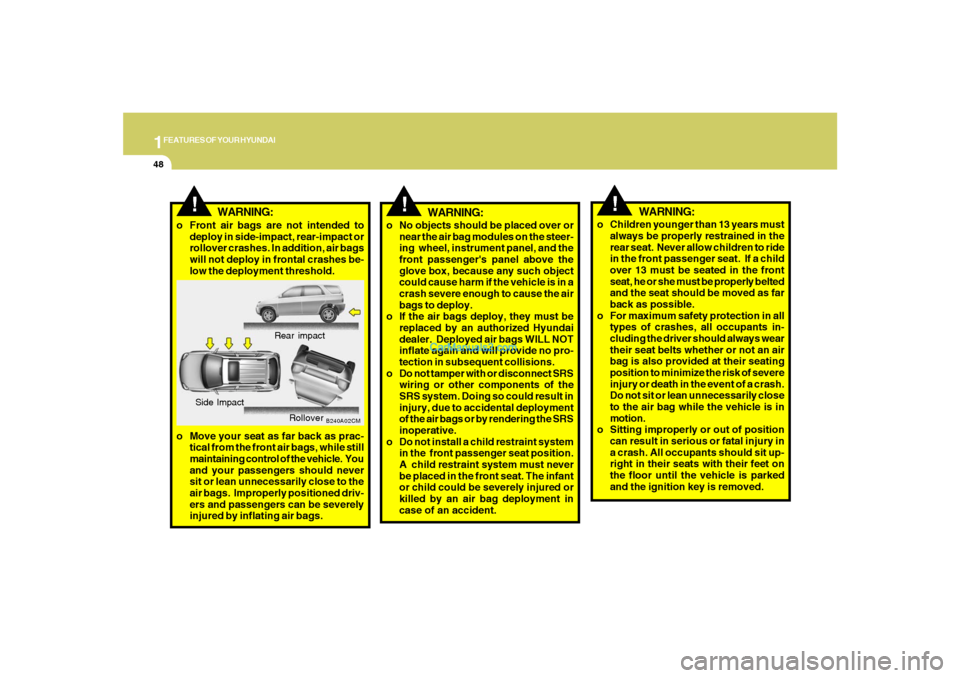
1FEATURES OF YOUR HYUNDAI48
!
WARNING:
o No objects should be placed over or
near the air bag modules on the steer-
ing wheel, instrument panel, and the
front passenger's panel above the
glove box, because any such object
could cause harm if the vehicle is in a
crash severe enough to cause the air
bags to deploy.
o If the air bags deploy, they must be
replaced by an authorized Hyundai
dealer. Deployed air bags WILL NOT
inflate again and will provide no pro-
tection in subsequent collisions.
o Do not tamper with or disconnect SRS
wiring or other components of the
SRS system. Doing so could result in
injury, due to accidental deployment
of the air bags or by rendering the SRS
inoperative.
o Do not install a child restraint system
in the front passenger seat position.
A child restraint system must never
be placed in the front seat. The infant
or child could be severely injured or
killed by an air bag deployment in
case of an accident.
o Children younger than 13 years must
always be properly restrained in the
rear seat. Never allow children to ride
in the front passenger seat. If a child
over 13 must be seated in the front
seat, he or she must be properly belted
and the seat should be moved as far
back as possible.
o For maximum safety protection in all
types of crashes, all occupants in-
cluding the driver should always wear
their seat belts whether or not an air
bag is also provided at their seating
position to minimize the risk of severe
injury or death in the event of a crash.
Do not sit or lean unnecessarily close
to the air bag while the vehicle is in
motion.
o Sitting improperly or out of position
can result in serious or fatal injury in
a crash. All occupants should sit up-
right in their seats with their feet on
the floor until the vehicle is parked
and the ignition key is removed.
!
WARNING:
B240A02CM
!
Rear impact
Side Impact
Rollover
o Move your seat as far back as prac-
tical from the front air bags, while still
maintaining control of the vehicle. You
and your passengers should never
sit or lean unnecessarily close to the
air bags. Improperly positioned driv-
ers and passengers can be severely
injured by inflating air bags.
WARNING:
o Front air bags are not intended to
deploy in side-impact, rear-impact or
rollover crashes. In addition, air bags
will not deploy in frontal crashes be-
low the deployment threshold.
Page 68 of 355
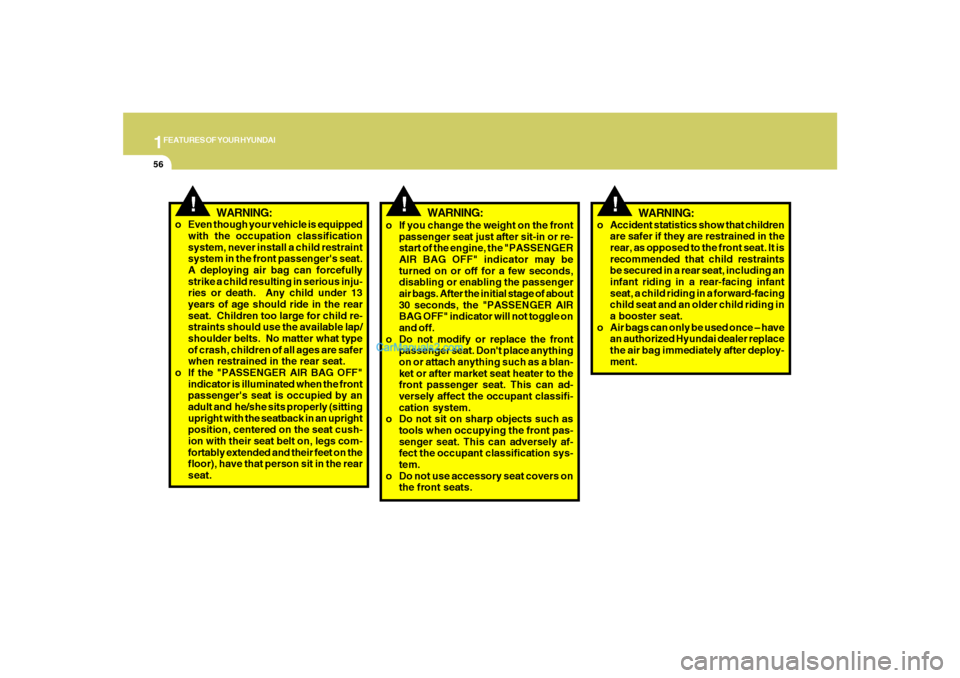
1FEATURES OF YOUR HYUNDAI56
!
WARNING:
o Accident statistics show that children
are safer if they are restrained in the
rear, as opposed to the front seat. It is
recommended that child restraints
be secured in a rear seat, including an
infant riding in a rear-facing infant
seat, a child riding in a forward-facing
child seat and an older child riding in
a booster seat.
o Air bags can only be used once – have
an authorized Hyundai dealer replace
the air bag immediately after deploy-
ment.
!
WARNING:
o If you change the weight on the front
passenger seat just after sit-in or re-
start of the engine, the "PASSENGER
AIR BAG OFF" indicator may be
turned on or off for a few seconds,
disabling or enabling the passenger
air bags. After the initial stage of about
30 seconds, the "PASSENGER AIR
BAG OFF" indicator will not toggle on
and off.
o Do not modify or replace the front
passenger seat. Don't place anything
on or attach anything such as a blan-
ket or after market seat heater to the
front passenger seat. This can ad-
versely affect the occupant classifi-
cation system.
o Do not sit on sharp objects such as
tools when occupying the front pas-
senger seat. This can adversely af-
fect the occupant classification sys-
tem.
o Do not use accessory seat covers on
the front seats.
!
WARNING:
o Even though your vehicle is equipped
with the occupation classification
system, never install a child restraint
system in the front passenger's seat.
A deploying air bag can forcefully
strike a child resulting in serious inju-
ries or death. Any child under 13
years of age should ride in the rear
seat. Children too large for child re-
straints should use the available lap/
shoulder belts. No matter what type
of crash, children of all ages are safer
when restrained in the rear seat.
o If the "PASSENGER AIR BAG OFF"
indicator is illuminated when the front
passenger's seat is occupied by an
adult and he/she sits properly (sitting
upright with the seatback in an upright
position, centered on the seat cush-
ion with their seat belt on, legs com-
fortably extended and their feet on the
floor), have that person sit in the rear
seat.
Page 73 of 355

1
FEATURES OF YOUR HYUNDAI
61
!
WARNING:
o Sitting improperly or out of position
can cause occupants to be shifted too
close to a deploying air bag, strike the
interior structure or be thrown from
the vehicle resulting in serious injury
or death.
o Always sit upright with the seatback
in an upright position, centered on the
seat cushion with your seat belt on,
legs comfortably extended and your
feet on the floor.
B240D02JM-AATAdditional Safety PrecautionsoNever let passengers ride in the cargo
area (trunk) or on top of a folded-down
back seat. All occupants should sit
upright, fully back in their seats with
their seat belts on and their feet on the
floor.
oPassengers should not move out of or
change seats while the vehicle is mov-
ing. A passenger who is not wearing a
seat belt during a crash or emergency
stop can be thrown against the inside of
the vehicle, against other occupants, or
out of the vehicle.
oEach seat belt is designed to restrain
one occupant. If more than one person
uses the same seat belt, they could be
seriously injured or killed in a collision.
oDo not use any accessories on seat
belts. Devices claiming to improve oc-
cupant comfort or reposition the seat
belt can reduce the protection provided
by the seat belt and increase the chance
of serious injury in a crash.
oPassengers should not place hard or
sharp objects between themselves
and the air bags. Carrying hard or sharp
objects on your lap or in your mouth can
result in injuries if an air bag inflates.oKeep occupants away from the air
bag covers. All occupants should sit
upright, fully back in their seats with
their seat belts on and their feet on the
floor. If occupants are too close to the air
bag covers, they could be injured if the
air bags inflate.
oDo not attach or place objects on or
near the air bag covers. Any object
attached to or placed on the front or side
impact air bag covers could interfere
with the proper operation of the air bags.
oDo not modify the front seats. Modifi-
cation of the front seats could interfere
with the operation of the supplemental
restraint system sensing components
or side impact air bags.
oDo not place items under the front
seats. Placing items under the front
seats could interfere with the operation
of the supplemental restraint system
sensing components and wiring har-
nesses.
oNever hold an infant or child on your
lap. The infant or child could be seri-
ously injured or killed in the event of a
crash. All infants and children should
be properly restrained in appropriate
child safety seats or seat belts in the rear
seat.
Adding Equipment to or Modifying
Your Air bag-Equipped Vehicle.If you modify your vehicle by changing
your vehicle's frame, bumper system, front
end or side sheet metal or ride height, this
may affect the operation of your vehicle's
air bag system.